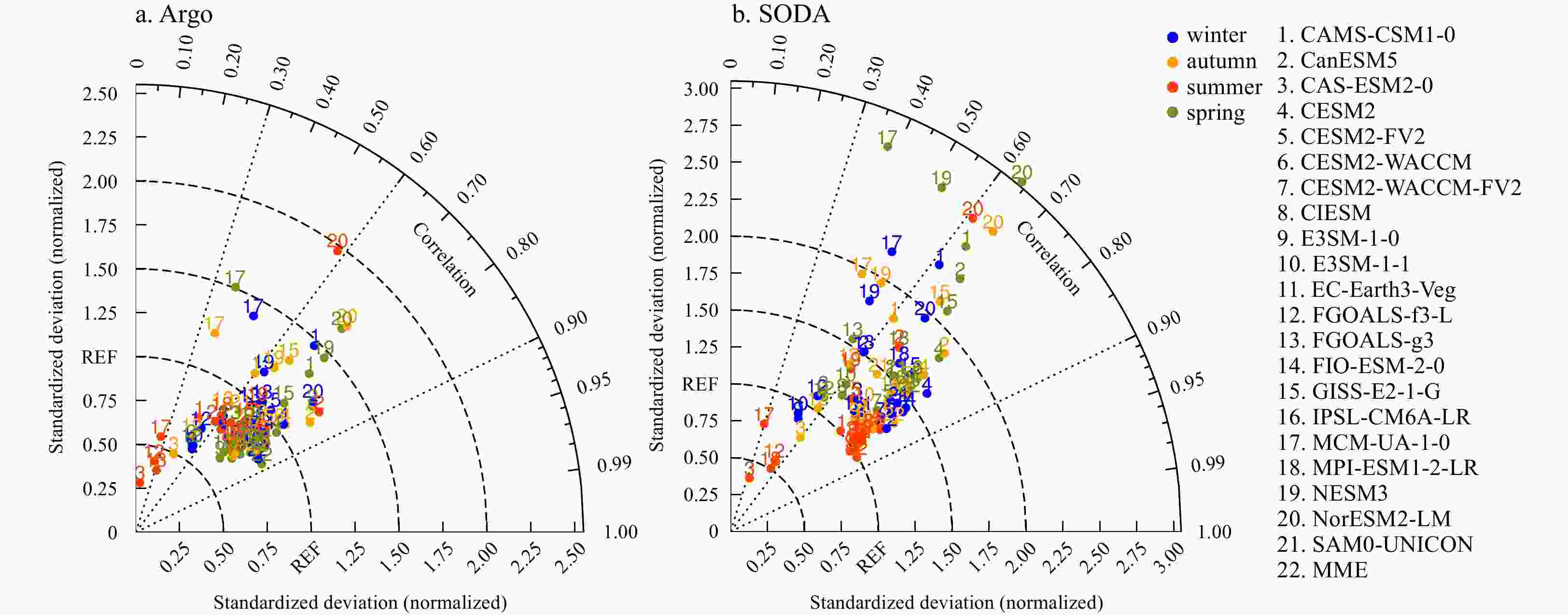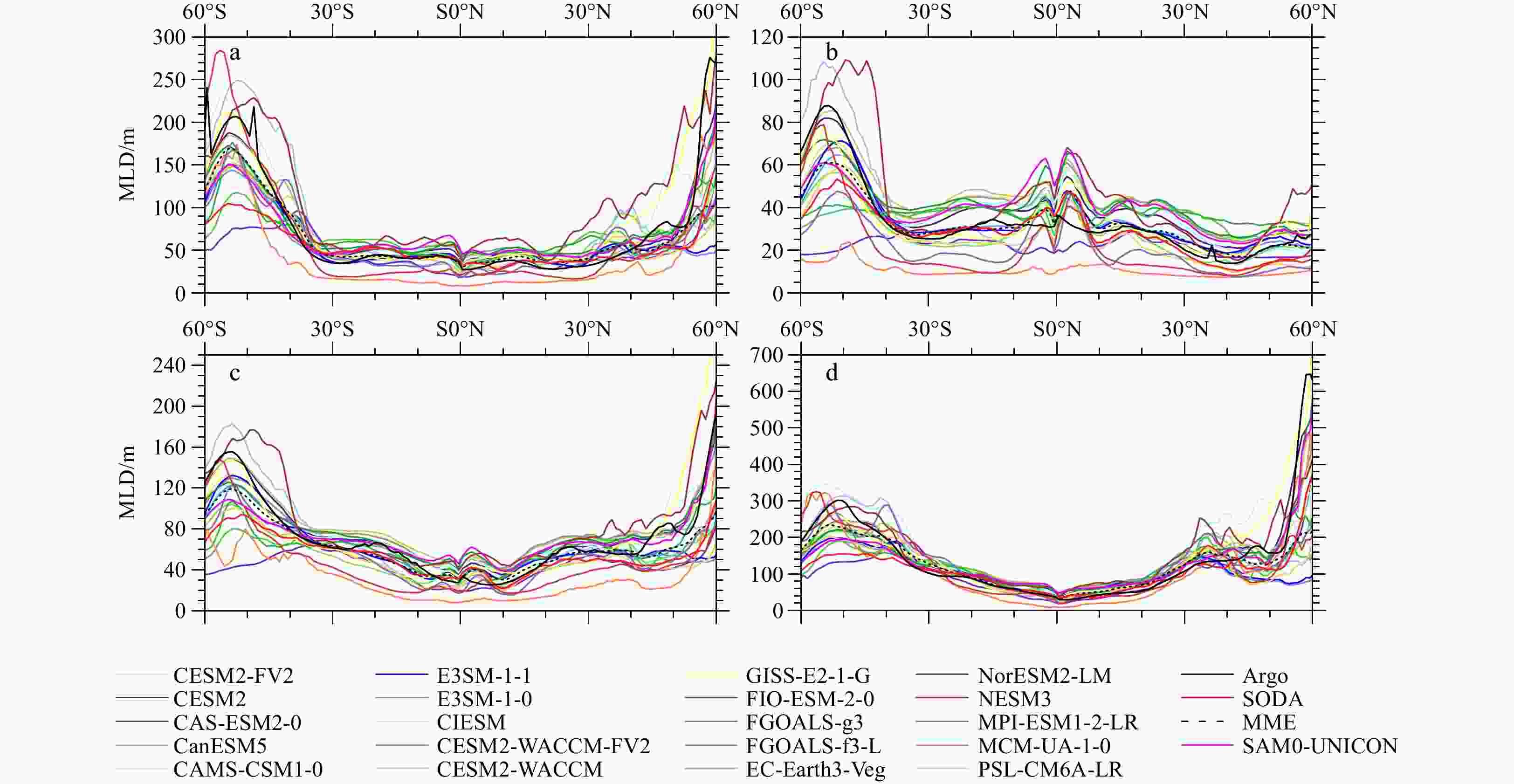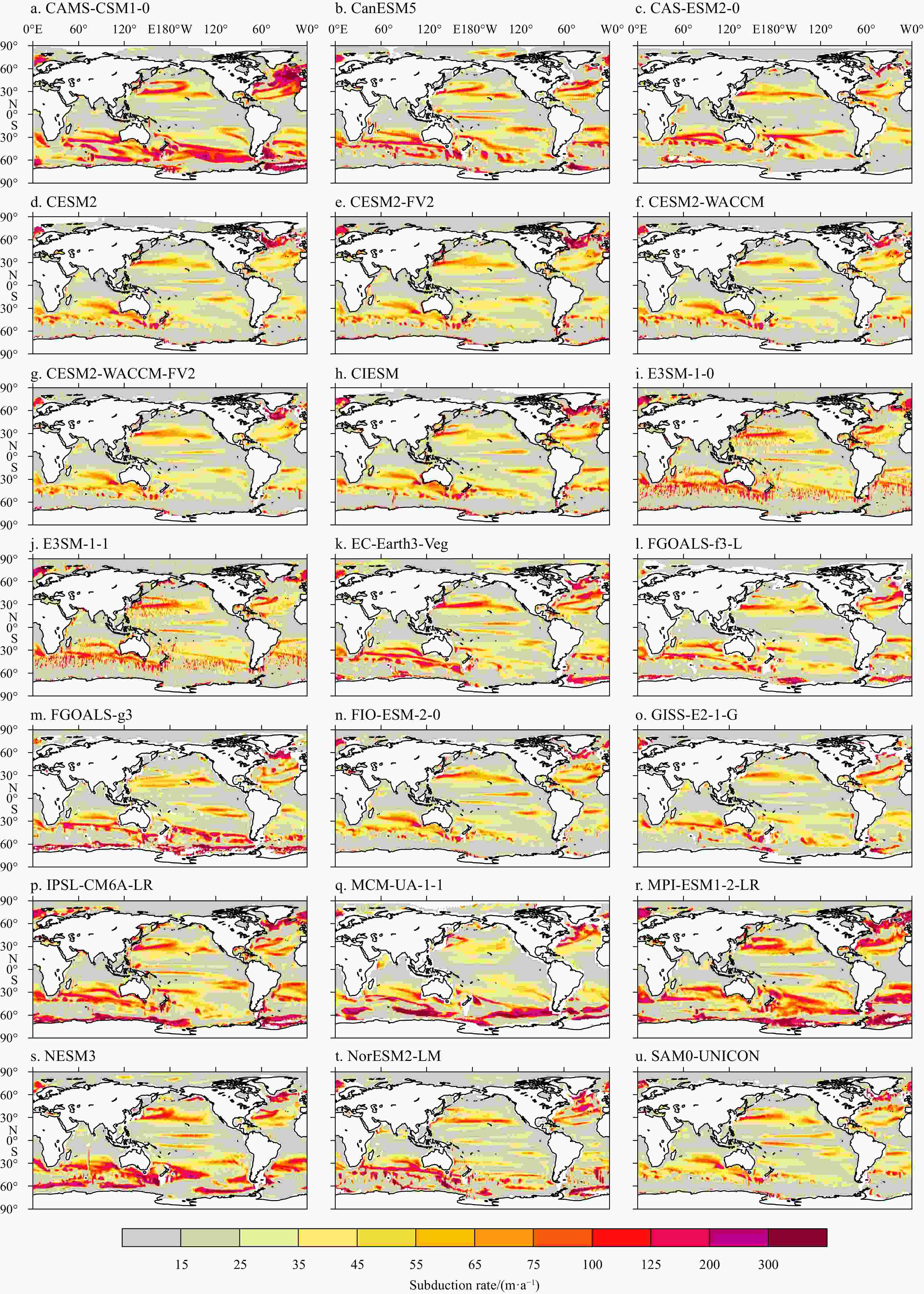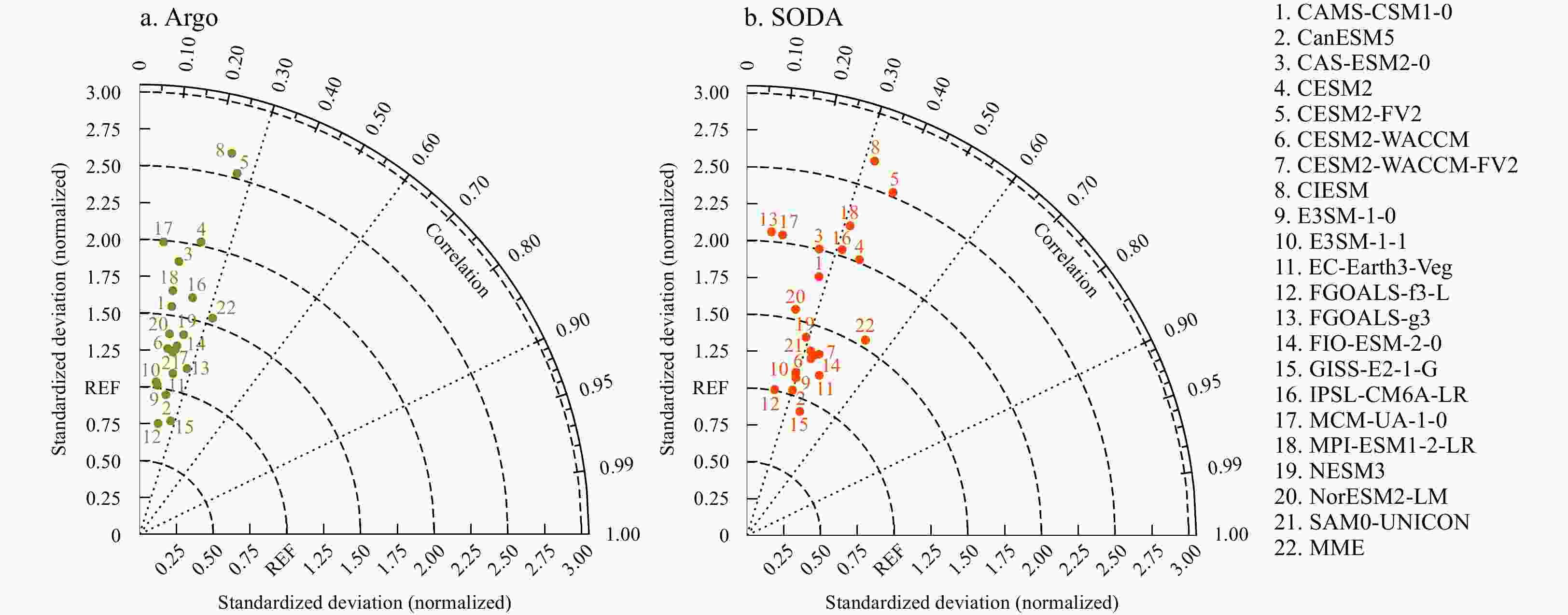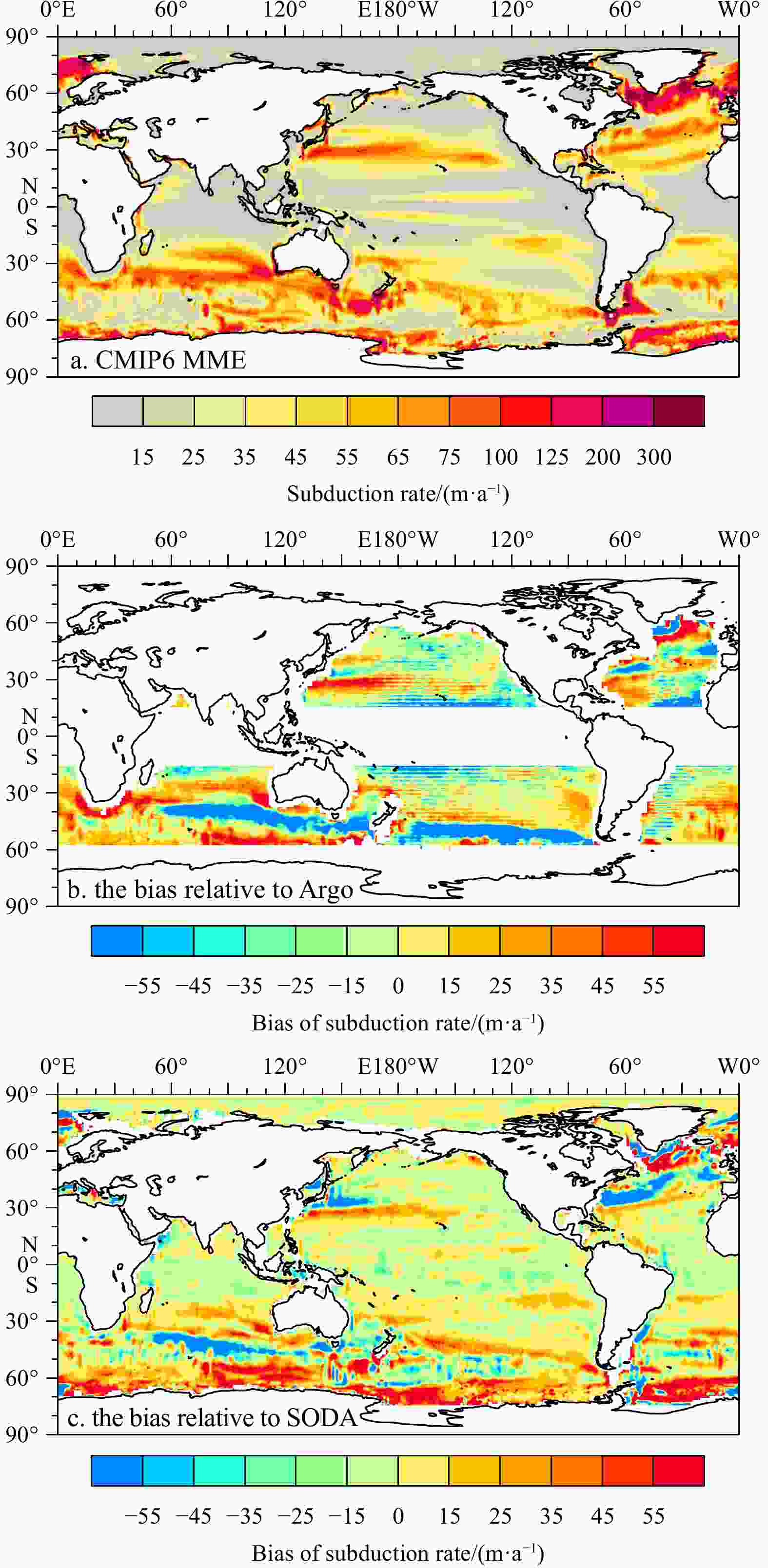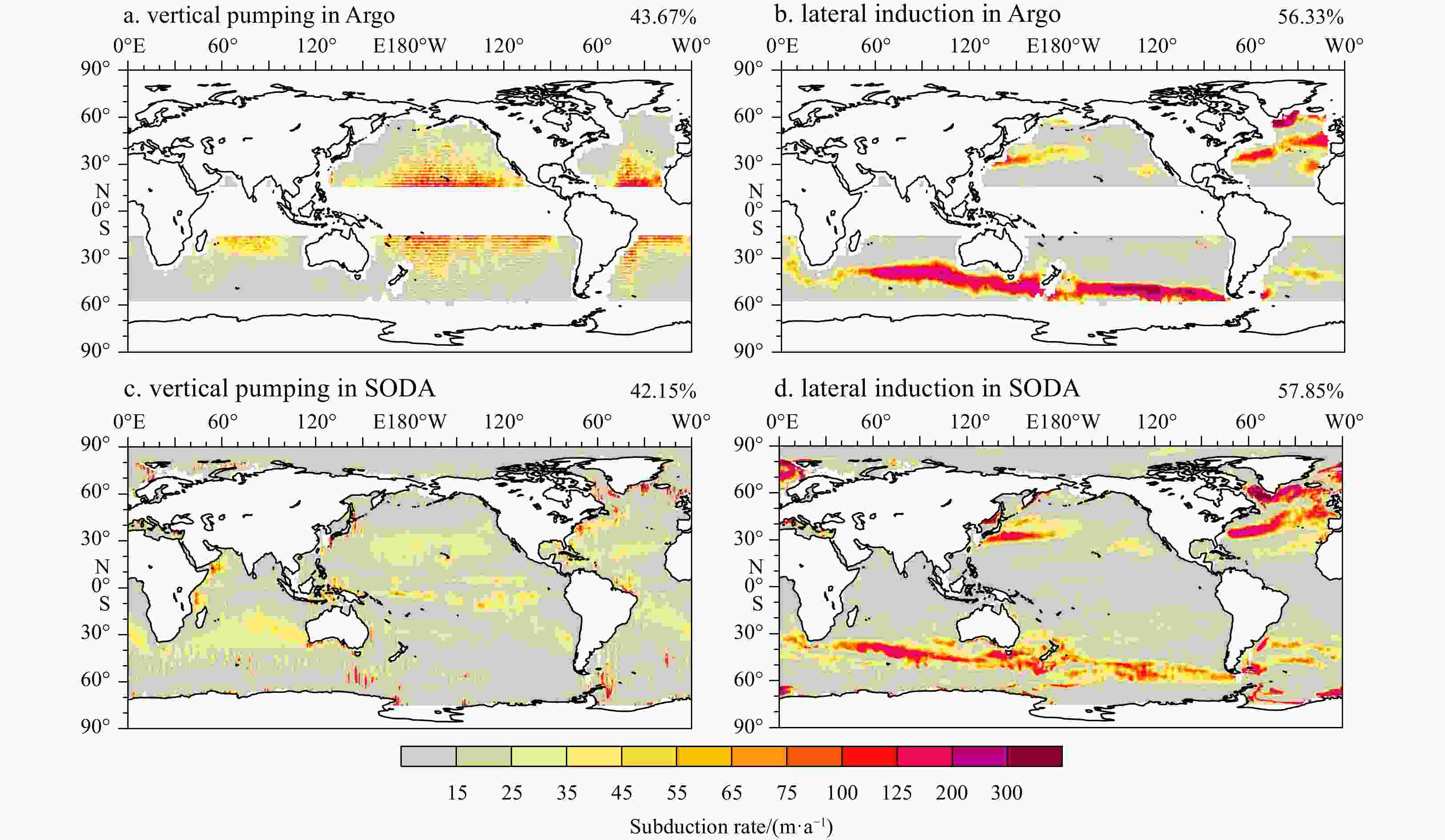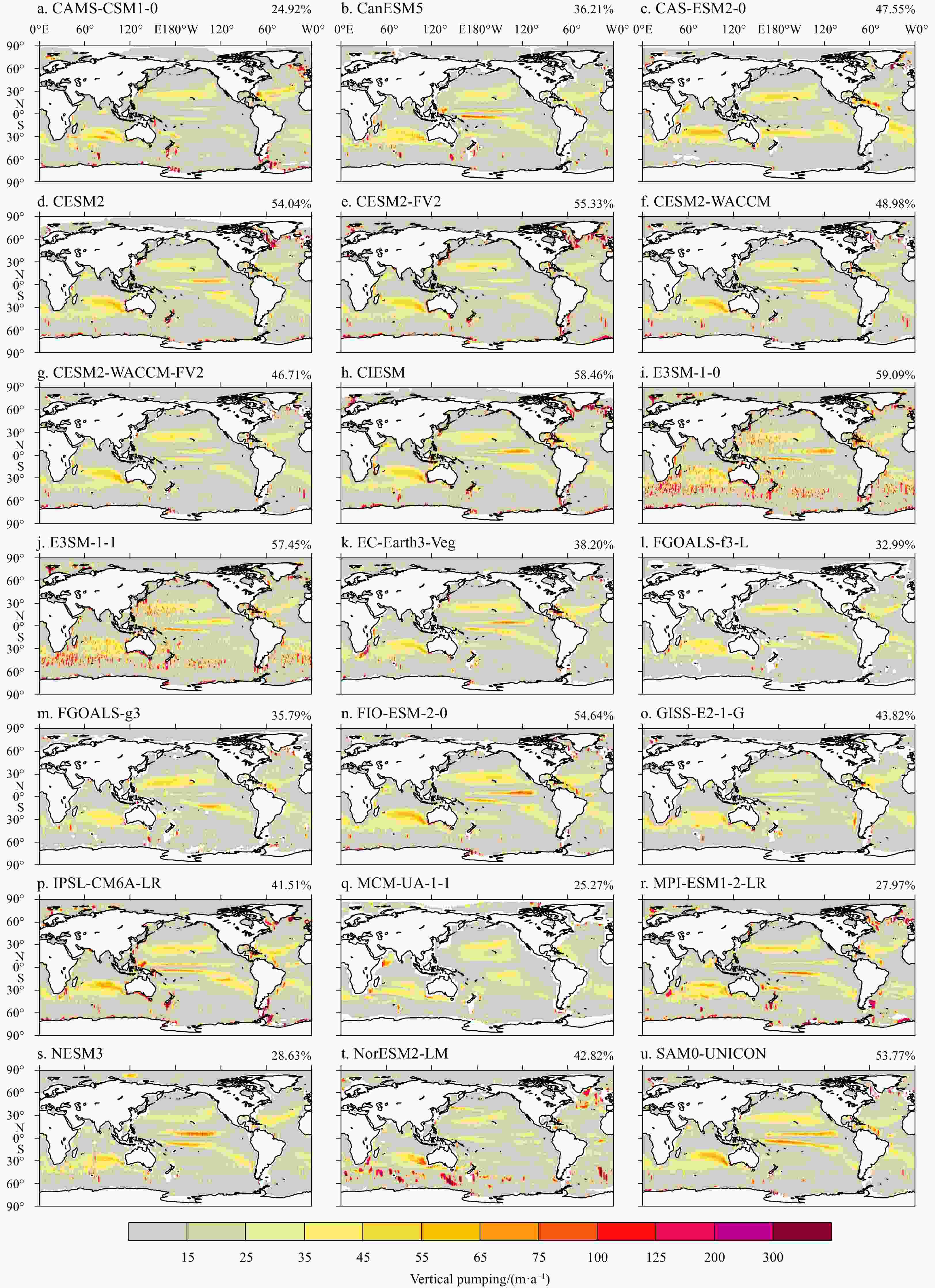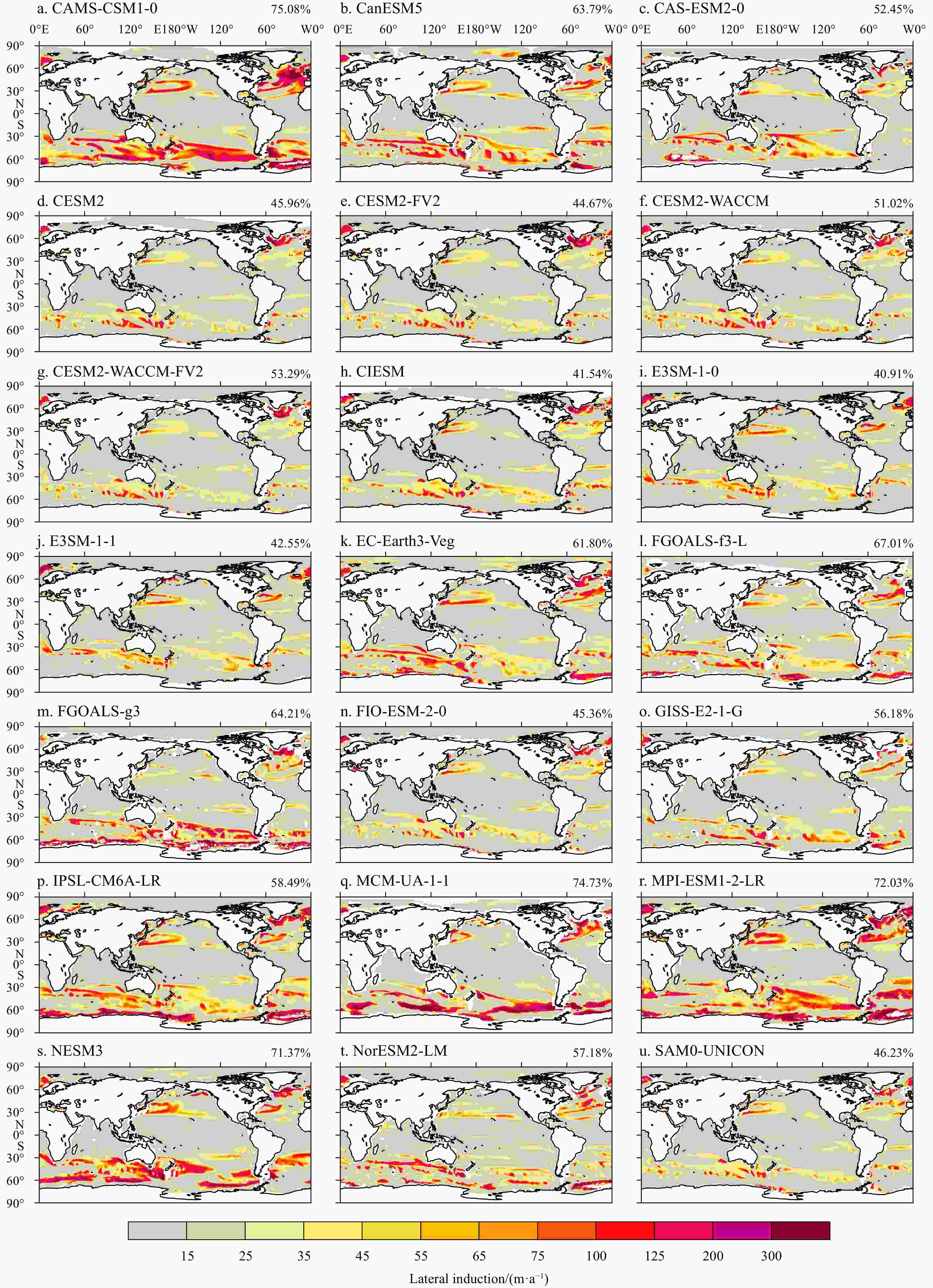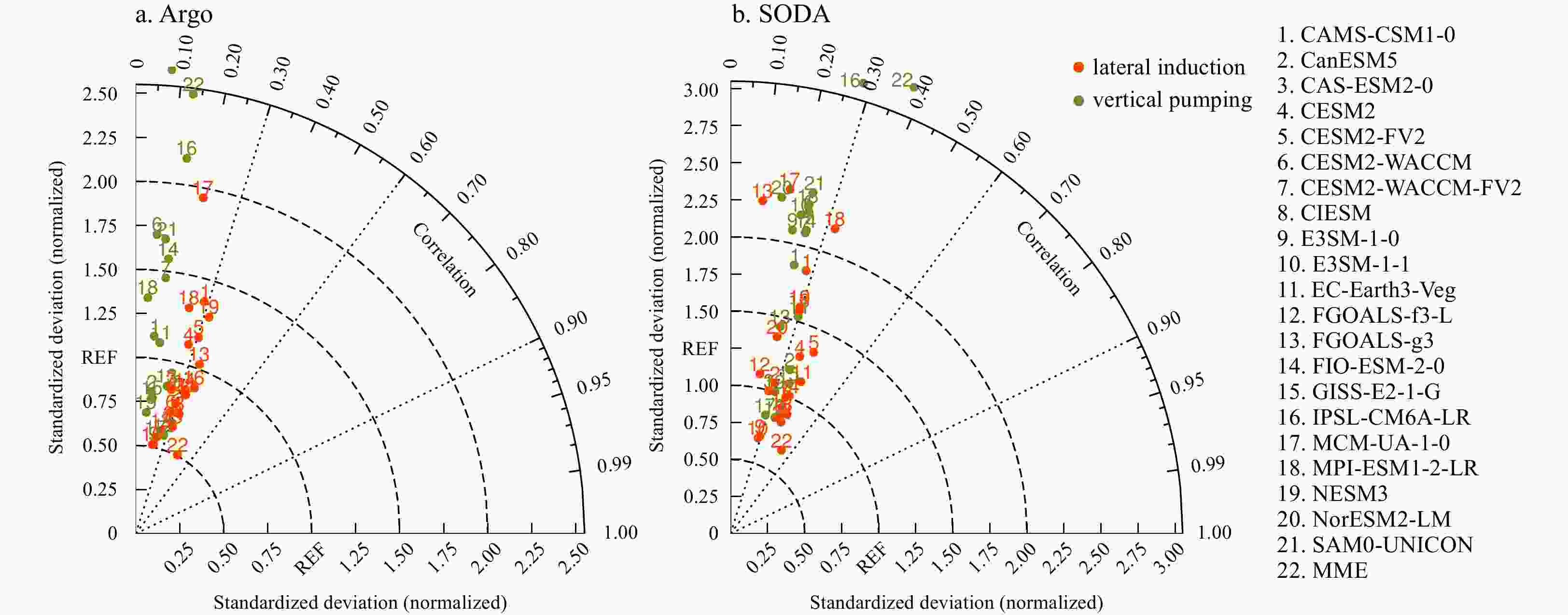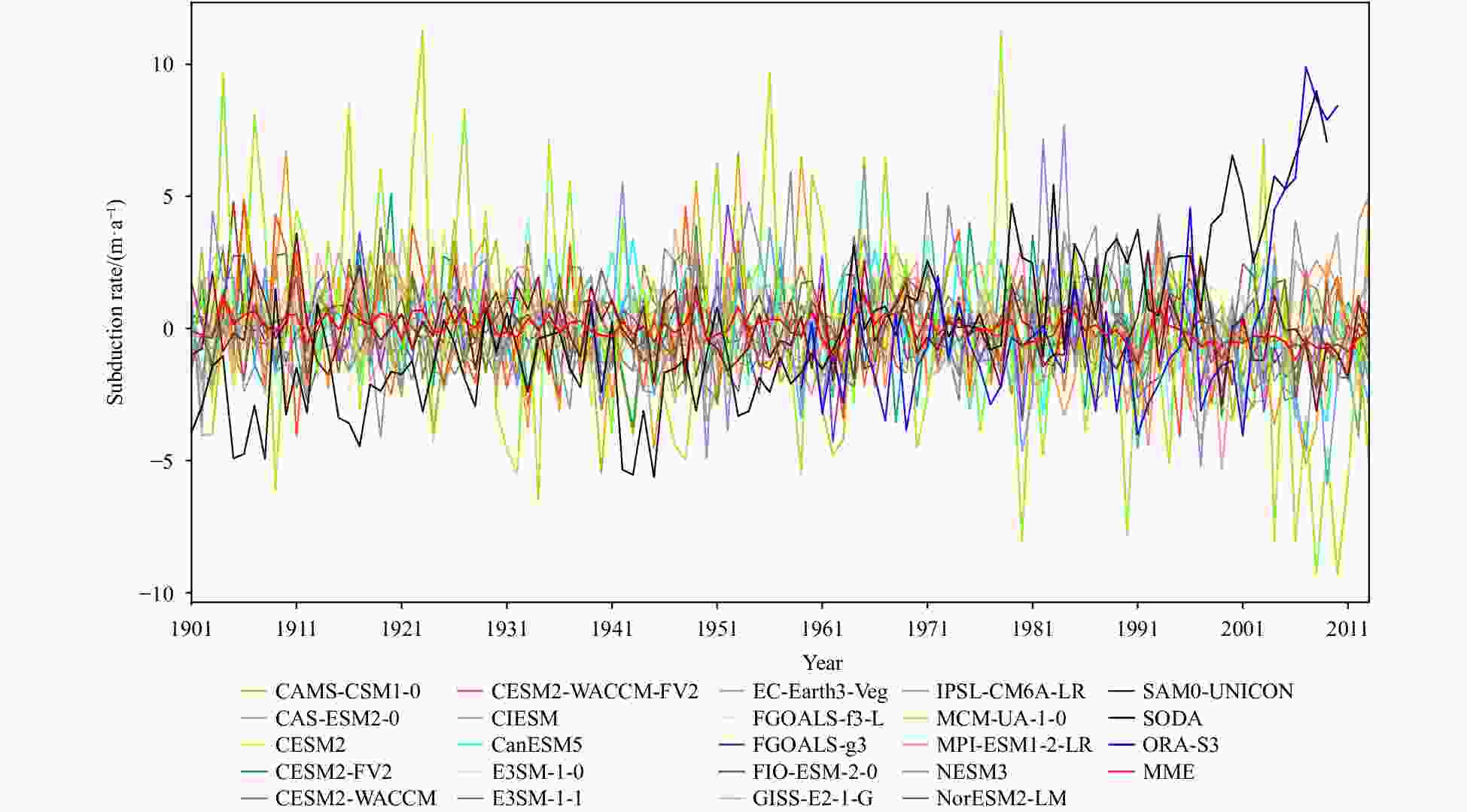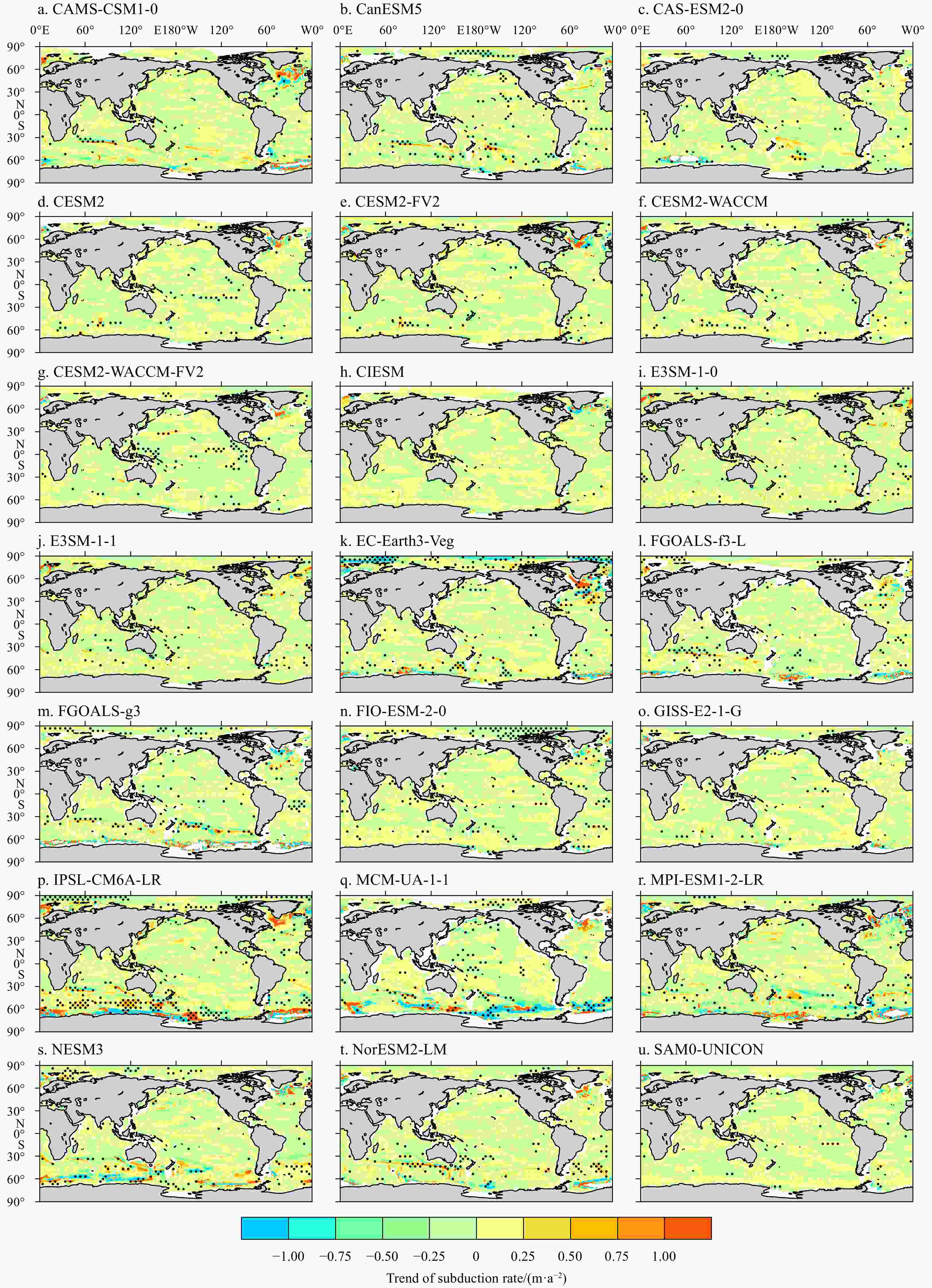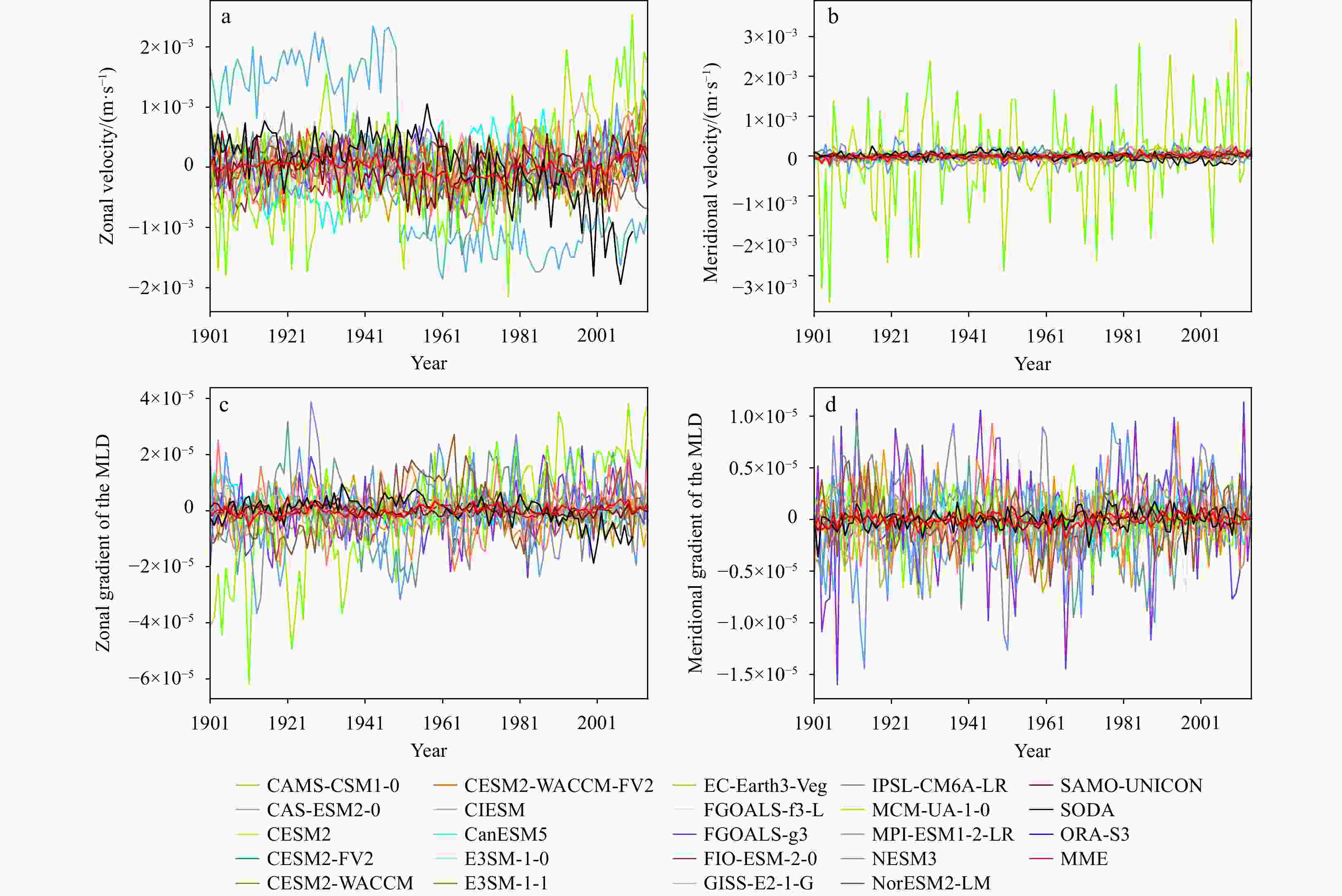-
Abstract: Subduction process is a dynamical bridge for the exchanges of heat between the atmosphere and subsurface ocean water, which is regarded as a central proxy for the ocean climate studies. Given its key indicator in climate signals, it is of importance to examine the ability of a model to simulate the global subduction rate before investigating the climate dynamics. In this paper, we evaluated the ability of 21 climate models from Coupled Model Intercomparison Project Phase 6 (CMIP6) in simulating the subduction rate. In general, the simulation ability of the models to the subduction climatology is better than that to the long-term variation trend. Based on the comprehensive analysis of climatology distribution and long-term trend of the subduction rate, GISS-E2-1-G performs better in reproducing the subduction rate climatology and IPSL-CM6A-LR can simulate positive long-term trend for both the global mean subduction rate and the lateral induction term in the Antarctic Circumpolar Current (ACC) region. However, it is still challenging to capture both the distribution characteristics of the subduction climatology and the long-term temporal trend for the 21 CMIP6 models. In addition, the model results demonstrate that, the ACC area is the major region contributing to the long-term trend of the global mean subduction rate. The analysis in this paper indicates that the poor simulation ability of reproducing the long-term trend of global mean subduction rate might be attributed to the ocean dynamics, for example, the zonal velocity at the bottom mixed layer and zonal gradient of mixed layer depth.
-
Key words:
- subduction rate /
- CMIP6 /
- climatology /
- long-term trend
-
Figure 15. The latitude bands analyzed in the Antarctic Circumpolar Current (ACC) region (a), the black bold lines indicate the boundaries; time variation curves of the subduction rate, vertical pumping term and lateral induction term in the ACC region for the Simple Ocean Data Assimilation (SODA) data (b).
Figure 16. Time variation of the lateral induction term (TVLI) for the Simple Ocean Data Assimilation (SODA) data and Coupled Model Intercomparison Project Phase 6 (CMIP6) models. The solid line shows the SODA data results, the dotted line shows the model simulation results, and the value in the upper left corner is the linear slope of the model result.
Figure 17. Abnormal time variation curves of the zonal velocity at the bottom mixed layer (BML) (a), the meridional velocity at the BML (b), the zonal gradient of the mixed layer depth (MLD) (c) and the meridional gradient of the MLD for the Simple Ocean Data Assimilation (SODA) data, Coupled Model Intercomparison Project Phase 6 (CMIP6) models and multi-model ensemble mean (MME) in the Antarctic Circumpolar Current (ACC) region during September (d).
Table 1. Details of the Coupled Model Intercomparison Project Phase 6 (CMIP6) models
No. Model Institution Ocean modules Ocean resolution 1 CAMS-CSM1-0 BCC-CAMS/China MOM4 200×320 2 CanESM5 CCCMA/Canada NEMO3.4.1 290×361 3 CAS-ESM2-0 CAS/China LICOM2.0 196×362 4 CESM2 NCAR/USA POP2 384×320 5 CESM2-FV2 NCAR/USA POP2 384×320 6 CESM2-WACCM NCAR/USA POP2 384×320 7 CESM2-WACCM-FV2 NCAR/USA POP2 384×320 8 CIESM THU/China CIESM-OM 560×720 9 E3SM-1-0 LLNL/USA MPAS-Oceanv6.0 235 160 cells and 714 274 edges 10 E3SM-1-1 LLNL/USA MPAS-Oceanv6.0 235 160 cells and 714 274 edges 11 EC-Earth3-Veg AEMET/Spain NEMO3.6 292×362 12 FGOALS-f3-L CAS/China LICOM3.0 218×360 13 FGOALS-g3 CAS/China LICOM3.0 218×360 14 FIO-ESM-2-0 FIO-QNLM/China POP2-W 384×320 15 GISS-E2-1-G GISS/USA GISS Ocean 180×360 16 IPSL-CM6A-LR IPSL/France NMEO-OPA 332×362 17 MCM-UA-1-0 UA/USA MOM1.0 80×192 18 MPI-ESM1-2-LR MPI-M/Germany MPIOM1.63 220×256 19 NESM3 NUIST/China NEMOv3.4 362×384 20 NorESM2-LM NCC/Norway MICOM 384×360 21 SAM0-UNICON SNU/Korea POP2 384×320 -
Bates N R, Pequignet A C, Johnson R J, et al. 2002. A short-term sink for atmospheric CO2 in subtropical mode water of the North Atlantic Ocean. Nature, 420(6915): 489–493. doi: 10.1038/nature01253 Chen Xingrong, Liu Shan, Cao Yi, et al. 2018. Potential effects of subduction rate in the key ocean on global warming hiatus. Acta Oceanologica Sinica, 37(3): 63–68. doi: 10.1007/s13131-017-1130-z Chen Ju, Qu Tangdong, Sasaki Y N, et al. 2010. Anti-correlated variability in subduction rate of the western and eastern North Pacific Oceans identified by an eddy-resolving ocean GCM. Geophysical Research Letters, 37(23): L23608. doi: 10.1029/2010GL045239 Eyring V, Bony S, Meehl G A, et al. 2016. Overview of the coupled model intercomparison project phase 6 (CMIP6) experimental design and organization. Geoscientific Model Development, 9(5): 1937–1958. doi: 10.5194/gmd-9-1937-2016 Gao Libao, Rintoul S R, Yu Weidong. 2018. Recent wind-driven change in subantarctic mode water and its impact on ocean heat storage. Nature Climate Change, 8: 58–63. doi: 10.1038/s41558-017-0022-8 Giese B S, Ray S. 2011. El Niño variability in simple ocean data assimilation (SODA), 1871–2008. Journal of Geophysical Research: Oceans, 116(C2): C02024. doi: 10.1029/2010JC006695 Gu Daifang, Philander S G H. 1997. Interdecadal climate fluctuations that depend on exchanges between the Tropics and Extratropics. Science, 275(5301): 805–807. doi: 10.1126/science.275.5301.805 Herraiz-Borreguero L, Rintoul S R. 2010. Subantarctic mode water variability influenced by mesoscale eddies south of Tasmania. Journal of Geophysical Research: Oceans, 115(C4): C04004. doi: 10.1029/2008JC005146 Hong Yu, Du Yan, Xia Xingyue, et al. 2021. Subantarctic mode water and its long-term change in CMIP6 models. Journal of Climate, 34(23): 9385–9400. doi: 10.1175/JCLI-D-21-0133.1 Huang Ruixin, Qiu Bo. 1994. Three-dimensional structure of the wind-driven circulation in the subtropical North Pacific. Journal of Physical Oceanography, 24(7): 1608–1622. doi: 10.1175/1520-0485(1994)024<1608:TDSOTW>2.0.CO;2 Kelley M, Schmidt G A, Nazarenko L S, et al. 2020. GISS-E2.1: configurations and climatology. Journal of Advances in Modeling Earth Systems, 12(8): e2019MS002025. doi: 10.1029/2019MS002025 Kubokawa A. 1999. Ventilated thermocline strongly affected by a deep mixed layer: a theory for subtropical countercurrent. Journal of Physical Oceanography, 29(6): 1314–1333. doi: 10.1175/1520-0485(1999)029<1314:VTSABA>2.0.CO;2 Ladd C, Thompson L A. 2002. Decadal variability of North Pacific Central Mode Water. Journal of Physical Oceanography, 32(10): 2870–2881. doi: 10.1175/1520-0485(2002)0322.0.CO;2 Levitus S. 1982. Climatological Atlas of the World Ocean. Princeton, NJ: NOAA Li Guancheng, Cheng Lijing, Zhu Jiang, et al. 2020. Increasing ocean stratification over the past half-century. Nature Climate Change, 10(12): 1116–1123. doi: 10.1038/s41558-020-00918-2 Liu Zhengyu, Huang Boyin. 1998. Why is there a tritium maximum in the central equatorial Pacific thermocline?. Journal of Physical Oceanography, 28(7): 1527–1533. doi: 10.1175/1520-0485(1998)028<1527:WITATM>2.0.CO;2 Liu Lingling, Huang Ruixin. 2012. The global subduction/obduction rates: Their interannual and decadal variability. Journal of Climate, 25(4): 1096–1115. doi: 10.1175/2011JCLI4228.1 Liu Lingling, Wang Fan, Huang Ruixin. 2011. Enhancement of subduction/obduction due to hurricane-induced mixed layer deepening. Deep-Sea Research Part I: Oceanographic Research Papers, 58(6): 658–667. doi: 10.1016/j.dsr.2011.04.003 Liu Chengyan, Wu Lixin. 2012. An intensification trend of South Pacific Mode Water subduction rates over the 20th century. Journal of Geophysical Research: Oceans, 117(C7): C07009. doi: 10.1029/2011JC007755 Liu Cong, Xu Lixiao, Xie Shangping, et al. 2019. Effects of anticyclonic eddies on the multicore structure of the North Pacific subtropical mode water based on Argo observations. Journal of Geophysical Research: Oceans, 124(11): 8400–8413. doi: 10.1029/2019JC015631 Luo Yiyong, Liu Qinyu, Rothstein L M. 2009. Simulated response of North Pacific mode waters to global warming. Geophysical Research Letters, 36(23): L23609. doi: 10.1029/2009GL040906 Luo Yiyong, Liu Qinyu, Rothstein L M. 2011. Increase of South Pacific eastern subtropical mode water under global warming. Geophysical Research Letters, 38(1): L01601. doi: 10.1029/2010GL045878 Ma Jie, Lan Jian. 2017. Interannual variability of Indian Ocean subtropical mode water subduction rate. Climate Dynamics, 48(11): 4093–4107. doi: 10.1007/s00382-016-3322-1 McPhaden M J, Zhang Dongxiao. 2002. Slowdown of the meridional overturning circulation in the upper Pacific Ocean. Nature, 415(6872): 603–608. doi: 10.1038/415603a Oka E, Qiu Bo. 2012. Progress of North Pacific mode water research in the past decade. Journal of Oceanography, 68(1): 5–20. doi: 10.1007/s10872-011-0032-5 Oka E, Suga T. 2005. Differential formation and circulation of North Pacific central mode water. Journal of Physical Oceanography, 35(11): 1997–2011. doi: 10.1175/JPO2811.1 Palter J B, Lozier M S, Barber R T. 2005. The effect of advection on the nutrient reservoir in the North Atlantic subtropical gyre. Nature, 437(7059): 687–692. doi: 10.1038/nature03969 Qiu Zishan, Wei Zexun, Nie Xunwei, et al. 2021. Southeast Indian Subantarctic Mode water in the CMIP6 coupled models. Journal of Geophysical Research: Oceans, 126(7): e2020JC016872. doi: 10.1029/2020JC016872 Qu Tangdong, Chen Ju. 2009. A North Pacific decadal variability in subduction rate. Geophysical Research Letters, 36(22): L22602. doi: 10.1029/2009GL040914 Qu Tangdong, Xie Shangping, Mitsudera H, et al. 2002. Subduction of the North Pacific mode waters in a global high-resolution GCM. Journal of Physical Oceanography, 32(3): 746–763. doi: 10.1175/1520-0485(2002)032<0746:SOTNPM>2.0.CO;2 Sallée J B, Shuckburgh E, Bruneau N, et al. 2013a. Assessment of Southern Ocean water mass circulation and characteristics in CMIP5 models: Historical bias and forcing response. Journal of Geophysical Research: Oceans, 118(4): 1830–1844. doi: 10.1002/jgrc.20135 Sallée J B, Shuckburgh E, Bruneau N, et al. 2013b. Assessment of Southern Ocean mixed-layer depths in CMIP5 models: Historical bias and forcing response. Journal of Geophysical Research: Oceans, 118(4): 1845–1862. doi: 10.1002/jgrc.20157 Suga T, Aoki Y, Saito H, et al. 2008. Ventilation of the North Pacific subtropical pycnocline and mode water formation. Progress in Oceanography, 77(4): 285–297. doi: 10.1016/j.pocean.2006.12.005 Suga T, Hanawa K. 1995. The subtropical mode water circulation in the North Pacific. Journal of Physical Oceanography, 25(5): 958–970. doi: 10.1175/1520-0485(1995)025<0958:TSMWCI>2.0.CO;2 Toyama K, Iwasaki A, Suga T. 2015. Interannual variation of annual subduction rate in the North Pacific estimated from a gridded Argo product. Journal of Physical Oceanography, 45(9): 2276–2293. doi: 10.1175/JPO-D-14-0223.1 Xia Xingxue, Xu Lixiao, Xie Shangping, et al. 2021. Fast and slow responses of the Subantarctic Mode Water in the South Indian Ocean to global warming in CMIP5 extended RCP4.5 simulations. Climate Dynamics, 56(9): 3157–3171. doi: 10.1007/s00382-021-05635-w Xu Lixiao, Li Peiliang, Xie Shangping, et al. 2016. Observing mesoscale eddy effects on mode-water subduction and transport in the North Pacific. Nature Communications, 7: 10505. doi: 10.1038/ncomms10505 Xu Lixiao, Xie Shangping, Jing Zhao, et al. 2017. Observing subsurface changes of two anticyclonic eddies passing over the Izu-Ogasawara Ridge. Geophysical Research Letters, 44(4): 1857–1865. doi: 10.1002/2016GL072163 Xu Lixiao, Xie Shangping, McClean J L, et al. 2014. Mesoscale eddy effects on the subduction of North Pacific mode waters. Journal of Geophysical Research: Oceans, 119(8): 4867–4886. doi: 10.1002/2014JC009861 -




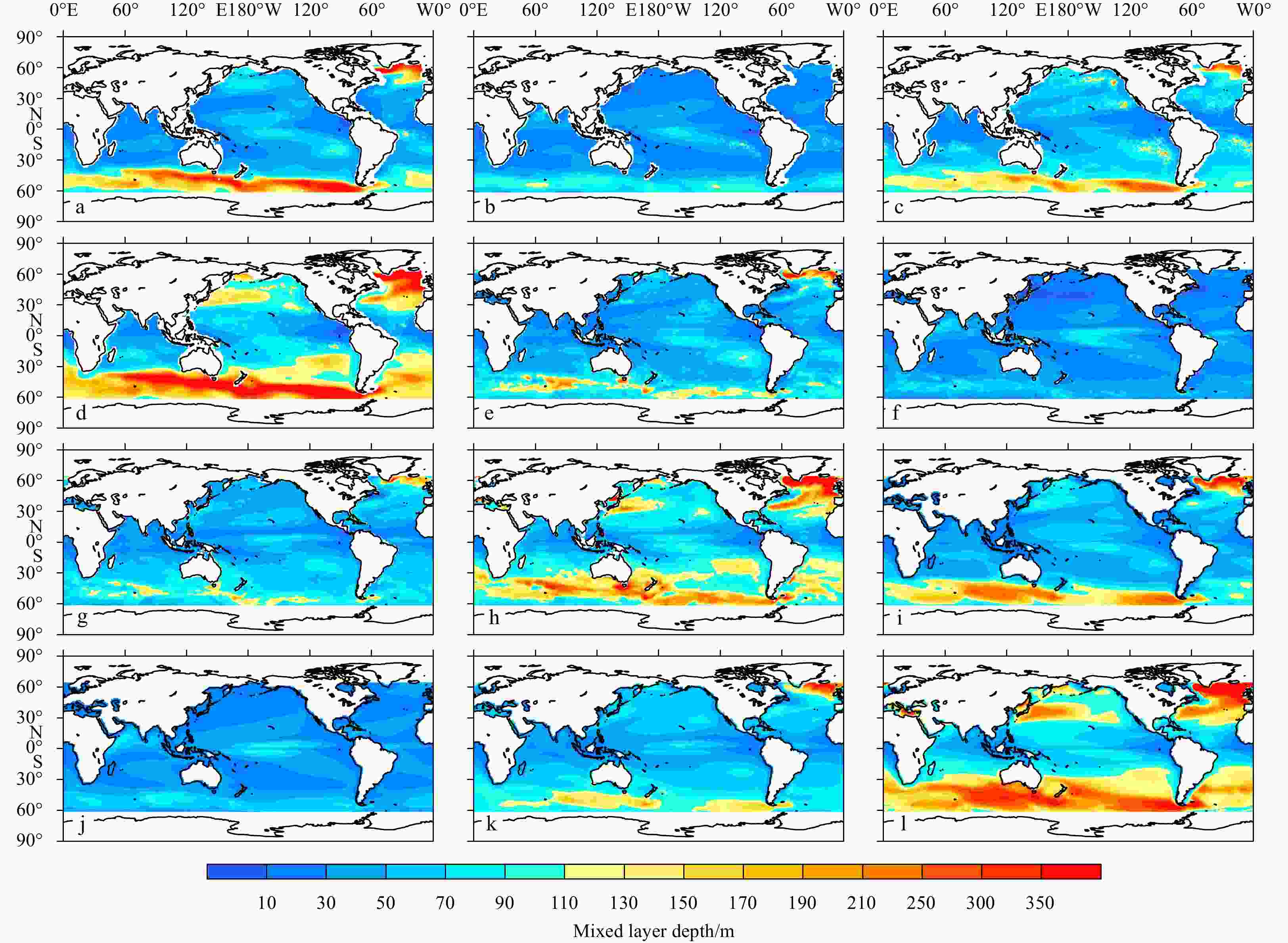
 下载:
下载:
